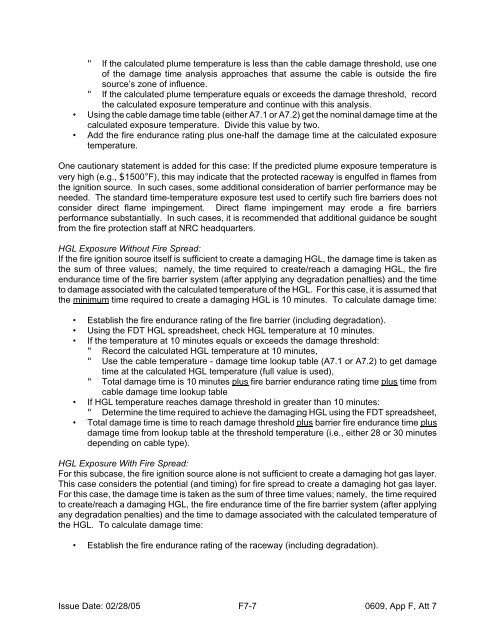IMC 0609, App F, Att 7 - NRC
IMC 0609, App F, Att 7 - NRC
IMC 0609, App F, Att 7 - NRC
You also want an ePaper? Increase the reach of your titles
YUMPU automatically turns print PDFs into web optimized ePapers that Google loves.
" If the calculated plume temperature is less than the cable damage threshold, use one<br />
of the damage time analysis approaches that assume the cable is outside the fire<br />
source’s zone of influence.<br />
" If the calculated plume temperature equals or exceeds the damage threshold, record<br />
the calculated exposure temperature and continue with this analysis.<br />
• Using the cable damage time table (either A7.1 or A7.2) get the nominal damage time at the<br />
calculated exposure temperature. Divide this value by two.<br />
• Add the fire endurance rating plus one-half the damage time at the calculated exposure<br />
temperature.<br />
One cautionary statement is added for this case: If the predicted plume exposure temperature is<br />
very high (e.g., $1500°F), this may indicate that the protected raceway is engulfed in flames from<br />
the ignition source. In such cases, some additional consideration of barrier performance may be<br />
needed. The standard time-temperature exposure test used to certify such fire barriers does not<br />
consider direct flame impingement. Direct flame impingement may erode a fire barriers<br />
performance substantially. In such cases, it is recommended that additional guidance be sought<br />
from the fire protection staff at <strong>NRC</strong> headquarters.<br />
HGL Exposure Without Fire Spread:<br />
If the fire ignition source itself is sufficient to create a damaging HGL, the damage time is taken as<br />
the sum of three values; namely, the time required to create/reach a damaging HGL, the fire<br />
endurance time of the fire barrier system (after applying any degradation penalties) and the time<br />
to damage associated with the calculated temperature of the HGL. For this case, it is assumed that<br />
the minimum time required to create a damaging HGL is 10 minutes. To calculate damage time:<br />
• Establish the fire endurance rating of the fire barrier (including degradation).<br />
• Using the FDT HGL spreadsheet, check HGL temperature at 10 minutes.<br />
• If the temperature at 10 minutes equals or exceeds the damage threshold:<br />
" Record the calculated HGL temperature at 10 minutes,<br />
" Use the cable temperature - damage time lookup table (A7.1 or A7.2) to get damage<br />
time at the calculated HGL temperature (full value is used),<br />
" Total damage time is 10 minutes plus fire barrier endurance rating time plus time from<br />
cable damage time lookup table<br />
• If HGL temperature reaches damage threshold in greater than 10 minutes:<br />
" Determine the time required to achieve the damaging HGL using the FDT spreadsheet,<br />
• Total damage time is time to reach damage threshold plus barrier fire endurance time plus<br />
damage time from lookup table at the threshold temperature (i.e., either 28 or 30 minutes<br />
depending on cable type).<br />
HGL Exposure With Fire Spread:<br />
For this subcase, the fire ignition source alone is not sufficient to create a damaging hot gas layer.<br />
This case considers the potential (and timing) for fire spread to create a damaging hot gas layer.<br />
For this case, the damage time is taken as the sum of three time values; namely, the time required<br />
to create/reach a damaging HGL, the fire endurance time of the fire barrier system (after applying<br />
any degradation penalties) and the time to damage associated with the calculated temperature of<br />
the HGL. To calculate damage time:<br />
• Establish the fire endurance rating of the raceway (including degradation).<br />
Issue Date: 02/28/05 F7-7<br />
<strong>0609</strong>, <strong>App</strong> F, <strong>Att</strong> 7
















